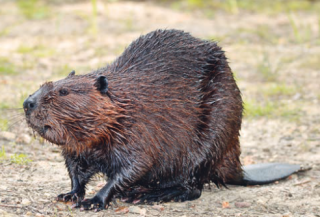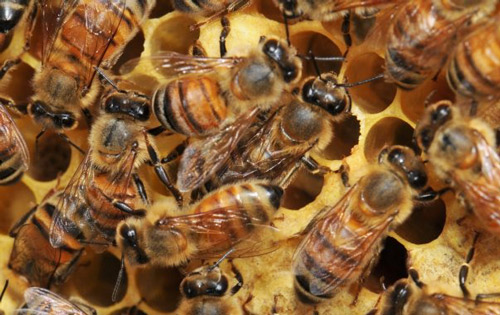
by Judy Biss | Aug 11, 2017

European Honey Bees
Photo: Ashley N. Mortensen; University of Florida
The UF/IFAS Extension Panhandle Agriculture Team is pleased to offer three intermediate level beekeeping classes. These classes will be offered via interactive web-conferencing at a number of Extension Offices across North Florida and will be taught by state and nationally recognized specialists. This summer series will be Thursday evenings from 6-7:30 pm Central Time, 7-8:30 pm Eastern Time. Each presentation will be followed by a question / answer period with the speaker. Registration for all three classes is $15 per person, or $25 for a family up to four, and covers course materials and refreshments.
Here is the lineup:
Thursday August 17th, Fall Pest and Disease Management -Varroa Mites and Nosema presented by Cameron Jack, UF/IFAS Bee Lab Apiarist
Thursday August 24th, Working With Pollination Contracts, presented by Jeanette Klopchin, FDACS Bureau of Plant and Apiary Inspection
Thursday September 7th, Minimizing Honey Bee Exposure to Pesticides, presented by Jeanette Klopchin, FDACS Bureau of Plant and Apiary Inspection.
Here is a link to a printable flyer and further details: Beekeeping in Panhandle Summer Series 2017.
Please call your local UF/IFAS Extension Office to register.
Call and register today!
by Judy Biss | Mar 17, 2017
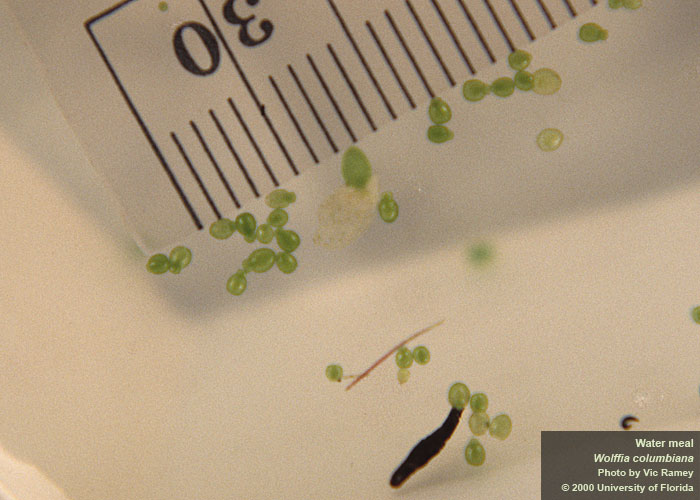
Water meal, the world’s smallest flowering plant. Photo by Vic Ramey, University of Florida/IFAS Center for Aquatic and Invasive Plants. Used with permission.
Some of the world’s smallest flowering plants grow in aquatic environments. And a number of these tiny aquatic plants grow natively right here in Florida! Aquatic plants of all kinds display an amazing array of adaptations for growing in water. They can tolerate drought, flood, flowing water, stagnant water, cold spring runs, and warm brackish marshes. They grow in sun and shade and nutrient rich to nutrient poor waters. Some of their adaptations include the ways in which they grow such as being rooted in bottom sediments, submerged, emerged, leaves floating on the surface, or completely free floating with their roots dangling into the water below.
The tiniest of aquatic plants are in this group of free floating plants. Let’s take a look at five of these tiny (less than ½ inch wide) plant species in Florida. They are most noticeable in slow moving waters, ponds, or coves protected from wind where many thousands of them form floating mats almost like paint on the water surface. Even though individual plants are small, some of these plant species are used by wildlife and invertebrates for food and cover. Oftentimes, especially in small ponds, these tiny floating plants can cover the entire water surface resulting in the need for management, especially if the ponds are used for irrigation or livestock watering.
In this article we will look at the native species, but as you are probably aware, there are also non-native representatives of these tiny plants established in our waters, but that is a story for another time…
The images and text below are from the UF/IFAS Center for Aquatic and Invasive Species website, list of Plants Sorted by Common Name.
Watermeal
“Water meal, native to Florida, is a tiny, floating, rootless plant. At 1 to 1.5 mm long, it is the smallest flowering plant on earth. It is occasionally found growing in rivers, ponds, lakes, and sloughs of the peninsula and central panhandle of Florida (Wunderlin, 2003).”
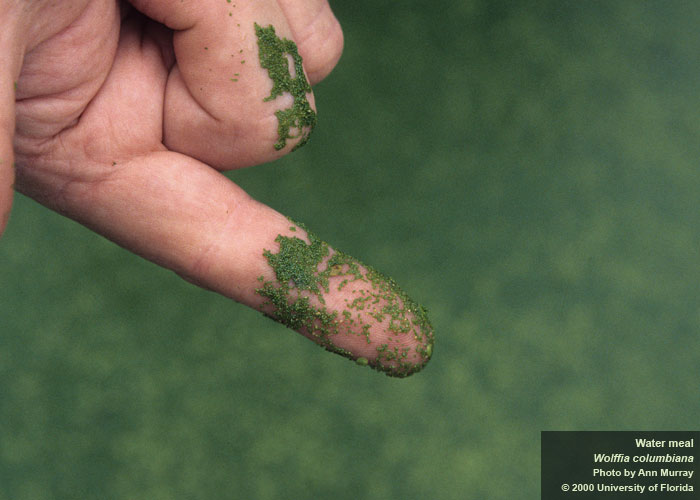
Water meal has a grainy feel and can be used as one clue in identifying this plant. Photo by Ann Murray, University of Florida/IFAS Center for Aquatic and Invasive Plants. Used with permission.
American Waterfern
“There are six species of Azolla in the world. American waterfern is the species commonly found in Florida. American waterfern is a small, free-floating fern, about one-half inch in size. It is most often found in still or sluggish waters. Young plants are, at first, a bright or grey-green. Azolla plants often turn red in color. American waterfern can quickly form large, floating mats.”
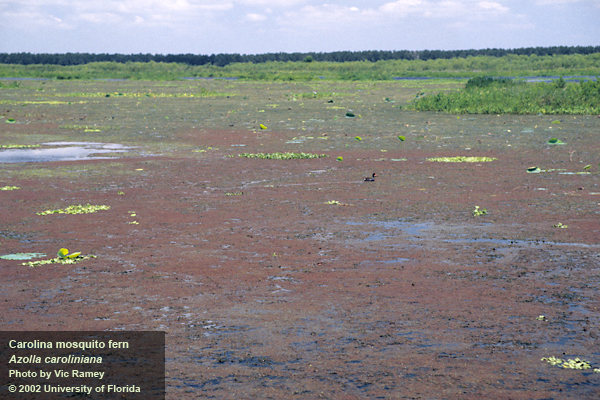
A large area of waterfern showing the reddish coloration. Photo by Vic Ramey, University of Florida/IFAS Center for Aquatic and Invasive Plants. Used with permission.
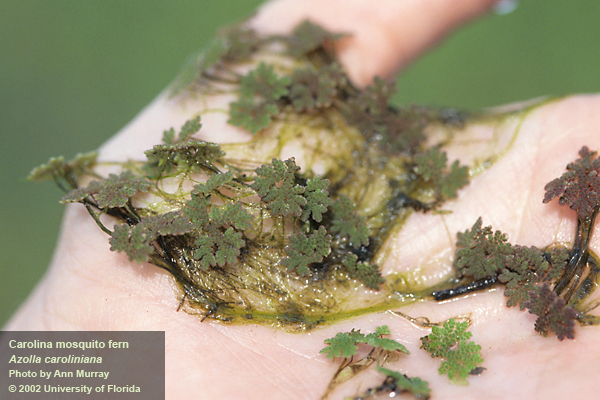
Close up of individual water fern plants. Photo by Ann Murray, University of Florida/IFAS Center for Aquatic and Invasive Plants. Used with permission.
Giant Duckweed
“Giant duckweed is a native floating plant in Florida. Though very small, it is the largest of the duckweeds…..frequently found growing in rivers, ponds, lakes, and sloughs from the peninsula west to the central panhandle of Florida (Wunderlin, 2003)… Giant duckweed has two to three rounded leaves, which are usually connected. Giant duckweeds usually have several roots (up to nine) hanging beneath each leaf. The underleaf surface of giant duckweed is dark red.”
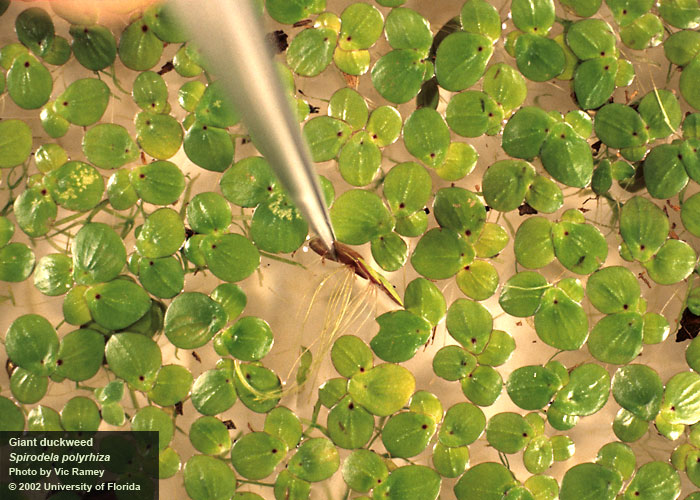
Close up of individual duckweed plants showing roots hanging freely below the plant. Photo by Vic Ramey, University of Florida/IFAS Center for Aquatic and Invasive Plants. Used with permission.
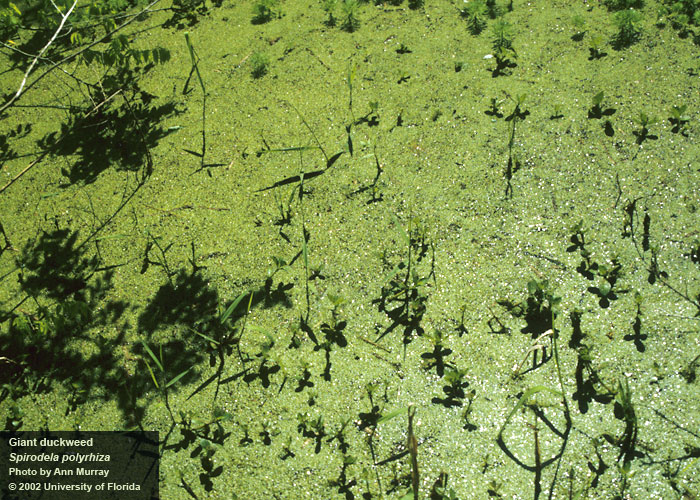
A typical scene of duckweed in a quiet cove or pond. Photo by Ann Murray, University of Florida/IFAS Center for Aquatic and Invasive Plants. Used with permission.
Small Duckweed
“Small duckweeds are floating plants. They are commonly found in still or sluggish waters. They often form large floating mats…. Small duckweeds are tiny (1/16 to 1/8 inch) green plants with shoe-shaped leaves. Each plant has two to several leaves joined at the base. A single root hangs beneath.”
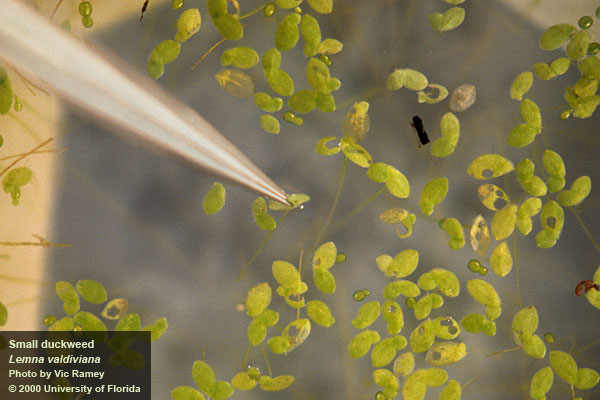
This is small duckweed, note the single root below each plant. Photo by Vic Ramey, University of Florida/IFAS Center for Aquatic and Invasive Plants. Used with permission.
Mudmidget
“Mud-midget, native to Florida, is another small duckweed, but this one has narrow, elongated fronds. The fronds are usually connected to form starlike colonies. The fronds are 5-10 mm long; the flowers are extremely small and difficult to see. Mud-midget plants float just beneath the surface of the water and is frequently found growing in rivers, ponds, lakes, and sloughs from the peninsula west to the central panhandle of Florida (Wunderlin, 2003)….”
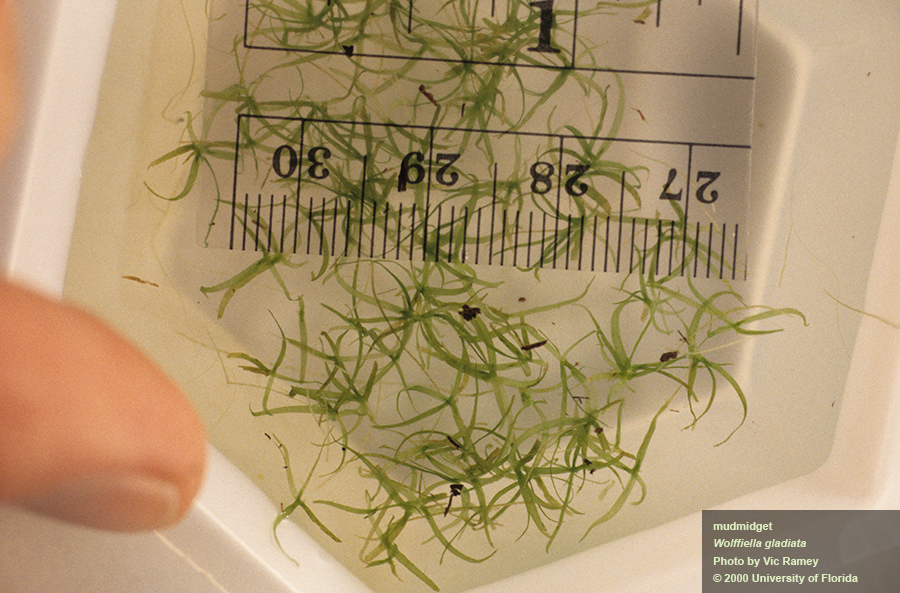
Mudmidget, Photo by Vic Ramey, University of Florida/IFAS Center for Aquatic and Invasive Plants. Used with permission.
If you have any questions about aquatic plant identification or management options, please contact your local UF/IFAS Extension County office. And, for more information on Florida’s aquatic plants, please see the following resources used for this article:
UF/IFAS Center for Aquatic and Invasive Species
Plants Sorted by Common Name
USDA Forest Service – Duckweed
USDA Forest Service – Water Fern
Native Aquatic and Wetland Plant Fact Sheets
Aquatic Plant Identification List with Pictures and Videos
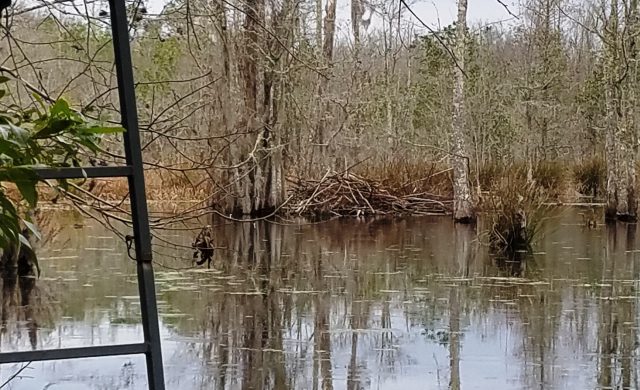
by Judy Biss | Mar 17, 2017
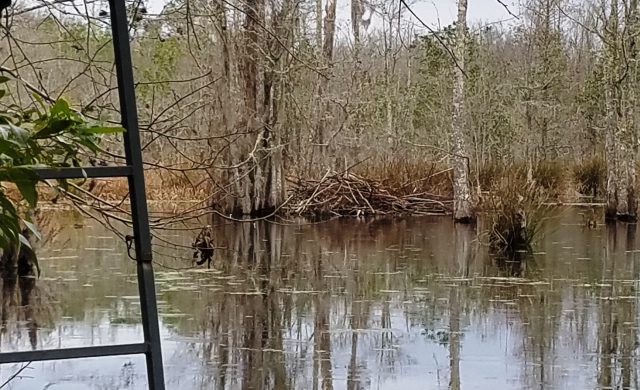
Beaver lodge, Calhoun County Florida. Photo by Judy Biss
Even though the “work” beavers do can sometimes cause frustration to land owners, they are truly amazing creatures. A number of questions have come into the Extension Office lately about managing beavers, so it is a good time to discuss a little about the history and biology of these unique animals, as well as the management options available for land owners.
Beavers in the American Landscape
Hundreds of millions of beaver once occupied the North American continent until the 1900s, when the majority had been trapped out in the eastern United States for the fur trade (Baker, B.W., and E.P. Hill. 2003. Beaver (Castor canadensis)). “Growing public concern over declines in beaver and other wildlife populations eventually led to regulations that controlled harvest through seasons and methods of take, initiating a continent-wide recovery of beaver populations.” (Baker, B.W., and E.P. Hill. 2003. Beaver (Castor canadensis)). In its current range, the beaver “thrives throughout the Florida Panhandle and upper peninsula in streams, rivers, swamps or lakes that have an ample supply of trees.” (Florida Fish and Wildlife Conservation Commission, Aquatic Mammals, Beaver: Castor canadensis).
Adaptations
Beavers are the largest rodent in North America. In Florida, they commonly weigh between 30 – 50 pounds. Beavers are considered an aquatic mammal, having adaptations such as a streamlined shape, insulating fur, ears and nostrils that close while underwater, clear membranes that cover their eyes while underwater, large webbed feet, and a broad flat rudder-like tail that aid in swimming. They can remain underwater for 15 minutes at a time! Their tree-cutting, bark-peeling front teeth grow continuously, and as a result, are continuously sharpened as they grind against the lower teeth. (Baker, B.W., and E.P. Hill. 2003. Beaver (Castor canadensis), Florida Fish and Wildlife Conservation Commission, Aquatic Mammals, Beaver: Castor canadensis).
Habitat and Behaviors
Beavers typically mate for life and live in family groups consisting of the adult male and female, and one or two generations of young kits before they are old enough to disperse on their own. They are primarily nocturnal, being active from dusk to dawn. Beavers eat not only tree bark, leaves, stems, buds, and fruits, but herbaceous plants as well. Their diet is broad and can consist of aquatic plants, such as cattails and water lilies, shrubs, willow, grasses, acorns, tree sap, and sometimes even cultivated row crops. (Baker, B.W., and E.P. Hill. 2003. Beaver (Castor canadensis)).
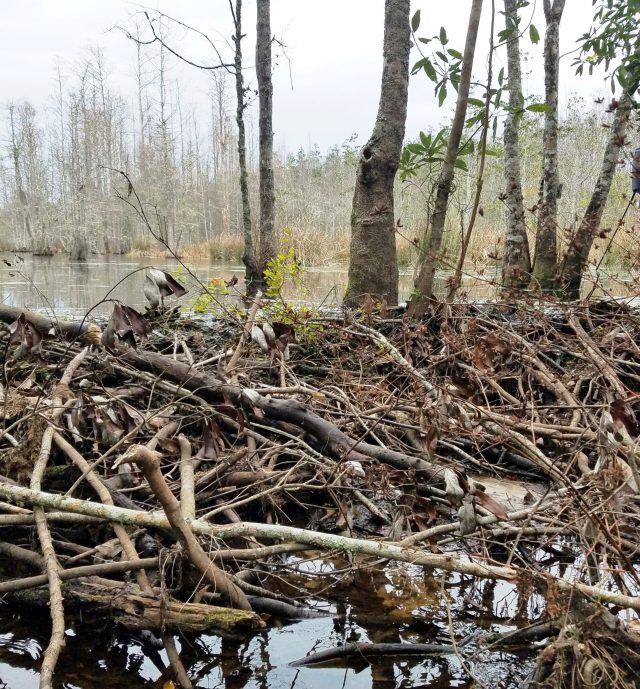
Top of beaver dam in Calhoun County FL. Water level difference is nearly 3 feet. Photo by Judy Biss
Dam and Lodge Construction
The sound of moving water triggers beavers to build, repair, or maintain their dams. (Baker, B.W., and E.P. Hill. 2003. Beaver (Castor canadensis)). The two main structures they build are the water-slowing dam and their living quarters or lodge. The lodge is separate from the dam and is oftentimes located in the stream or pond bank. “The ponds created by dams also provide beavers with deep water where they can find protection from predators — entrances to dens or lodges are usually underwater. Some beavers in Florida do not build the massive stick lodges associated with northern colonies. Instead, they are more likely to live in deep dens in stream banks…” Florida Fish and Wildlife Conservation Commission, Aquatic Mammals, Beaver: Castor canadensis).
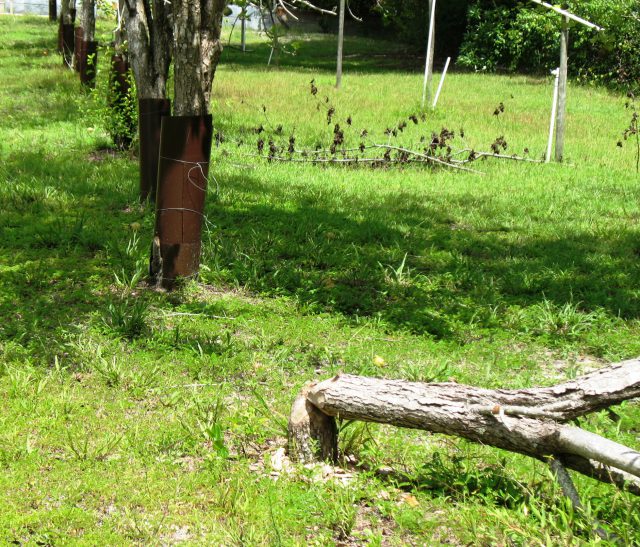
Pear tree felled by beaver in Calhoun County FL. Photo by Judy Biss
Impacts
Beavers are called “nature’s engineers” for good reason. Their tree cutting and building behaviors certainly alter surrounding landscapes. Outside of any connection to human civilization, their activities tend to increase diversity and habitat options for both plants and animals. Many scientists have examined the intricate biological and ecological effects beavers have on surrounding landscapes. Their activities in our backyard, however, do not always result in positive outcomes. Often, beavers are triggered to build dams in running water through road culverts causing significant impacts to road drainage, and surrounding flood management. Their construction of dams along creeks can flood farm fields and woodlands. Their feeding and tree cutting can kill desired trees in nearby timberland and orchards.
Management Options for Land Owners
The Florida Fish and Wildlife Conservation Commission (FWC) publication, “Living with Beavers” provides excellent advice, along with a summary of the regulations regarding this native wildlife species. As per this document, “The beaver is a native species with a year-round hunting and trapping season in Florida.” Beaver hunting and trapping regulations can be found on the FWC Furbearer Hunting and Trapping website. A beaver can be taken as a nuisance animal, if it causes or is about to cause property damage, presents a threat to public safety, or causes an annoyance in, under, or upon a building, per Florida Rule 68A-9.010.” Other recommendations from this FWC publication are:
- “Beaver dam removal provides immediate relief from flooding and can be the simplest and cheapest way of dealing with a beaver problem. However, beavers often quickly rebuild a dam as soon as it is damaged. “
- “When removing a dam is infeasible or unsuccessful, installing a water level control structure through the dam can allow for the control of water flow without removing the dam. This technique also reduces the likelihood of the beaver continuously blocking water flow. For technical assistance, contact a wildlife assistance biologist at a regional FWC office near you.”
- “If a beaver dam is blocking a culvert or similar structure, installing a barrier several feet away from the culvert can be the most effective solution. This prevents the beavers from accessing the culvert to dam it. Please contact a wildlife assistance biologist at a regional FWC office near you for technical assistance.”
- “Protect valuable trees and vegetation from beaver damage by installing a fence around them or wrapping tree trunks loosely with 3-5 feet of hardware cloth or multiple wraps of chicken wire. This prevents the beavers from chewing on the trees and other plants.”
- “Lethal control should be considered a last resort.”
FWC also points the reader to this publication from Clemson University Cooperative Extension Service, Department of Aquaculture, Fisheries and Wildlife, “The Clemson Beaver Pond Leveler.” This publication provides diagrams and a list of materials needed to construct a device which is designed to “minimize the probability that current flow can be detected by beavers, therefore minimizing dam construction.”
All questions regarding beaver management should be directed to your local FWC Regional Office. Land owners can also request a list of Nuisance Wildlife Trappers available in their area:
FWC Northwest Region Office
3911 Highway 2321
Panama City, FL 32409-1659
(850) 265-3676
Links to the references used for this article:
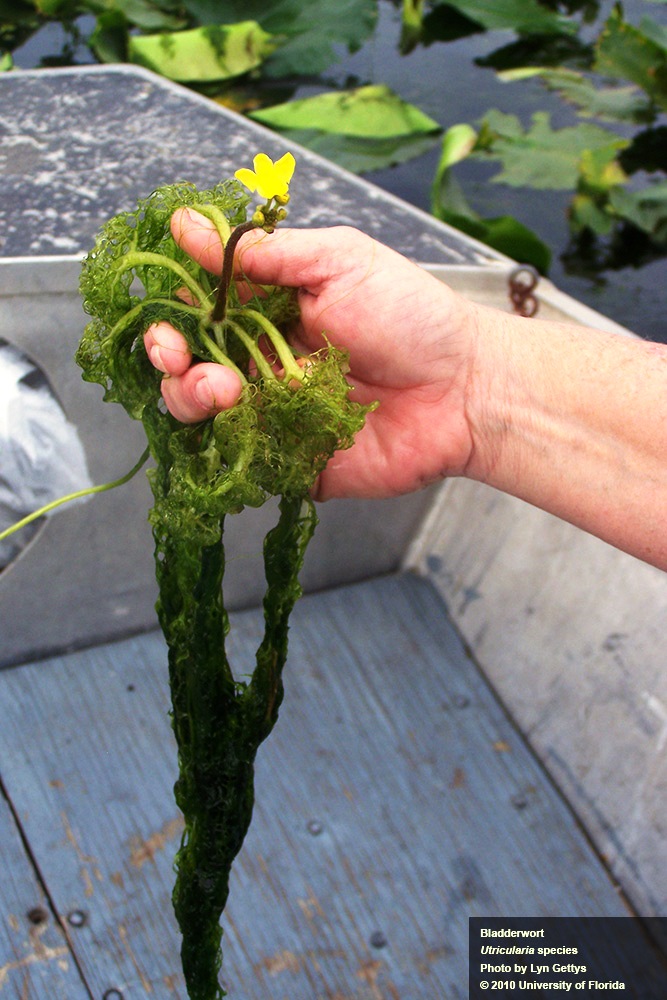
by Judy Biss | Jun 3, 2016

DId you know that Florida is home to 14 species of aquatic carnivorous plants called “bladderworts?” This one is Utricularia inflata. Photo by Lyn Gettys
I don’t know about you, but living in “La Florida” – “the land of flowers” (the Spanish translation of Florida – named in 1513 by Spanish explorer Juan Ponce de León) makes it difficult to have a short list of favorite plants. While I do have a number of plants in my “favorites” list, carnivorous plants are always at the top in the “wow, is that real?” category! Many people have read about, or have seen the carnivorous pitcher plant communities in Florida panhandle bogs, meadows, and seepage slopes, but did you also know that Florida is home to 14 species of aquatic carnivorous plants called “bladderworts?”
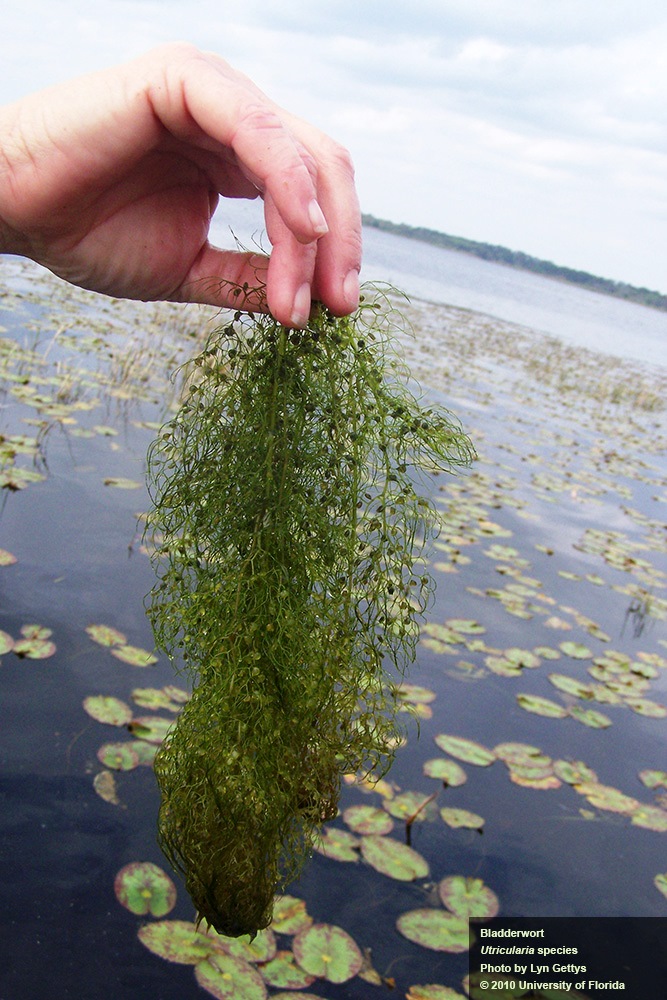
Utricularia’s many small bladders (only a few millimeters in size, and seen in this photo as small dark spots) actually trap and digest tiny aquatic invertebrates! Photo by Lyn Gettys
These bladderworts are in the genus Utricularia whose Latin meaning, “little bag,” is descriptive of the many small bladders (only a few millimeters in size) on the plant which actually trap and digest tiny aquatic invertebrates! Bladderworts are found in lakes, ponds, wetlands, and quiet coves of rivers and streams. They are commonly found in waters with low pH and low nutrients. One interesting fact is that bladderworts do not have roots. They have main stems from which lacy, intricate leaves grow. Like other plants, bladderworts produce food by photosynthesis; but the trapped invertebrates supplement the nutritional requirements of this plant. The Botanical Society of America reports that currently 220 species of Utricularia are found in temperate and tropical habitats throughout the world representing the most diverse and widespread genus of carnivorous plants.

A close-up of the tiny Utricularia bladders. Photo by Sturgis McKeever, Georgia Southern University, Bugwood.org
Similar to a Venus fly trap, hairs on the opening of the bladder act as triggers. When tiny prey swim by and contact these hairs, it causes the bladder to spring open and inflate, drawing in water and prey like a vacuum. Research has found that bacteria living in the traps act together in a mutualistic role to digest the food trapped in the bladders. An article in the Journal of Experimental Botany entitled “The carnivorous bladderwort (Utricularia, Lentibulariaceae): a system inflates,” details another fascinating aspect of these plants: the bladders often look like the tiny prey (microcrustaceans/cladocerans) they are catching.
“Darwin (1875), noted yet another insight: aquatic Utricularia bladders bear a striking resemblance to microcrustaceans. The bladder shape, surface reticulations, stalk, and especially the antennae and bristles resemble microcrustacean anatomy. Interestingly, the bladders most closely resemble the littoral zone cladocerans (bosminids and chydorids) that are frequently found or overrepresented in bladders (Guiral and Rougier, 2007; Alkhalaf et al., 2009)….Moreover, experiments reveal that the cladoceran-like structures of bladders significantly improve the capture rates of cladocerans (Meyers and Strickler, 1979; Harms, 1999; Jobson and Morris, 2001).”
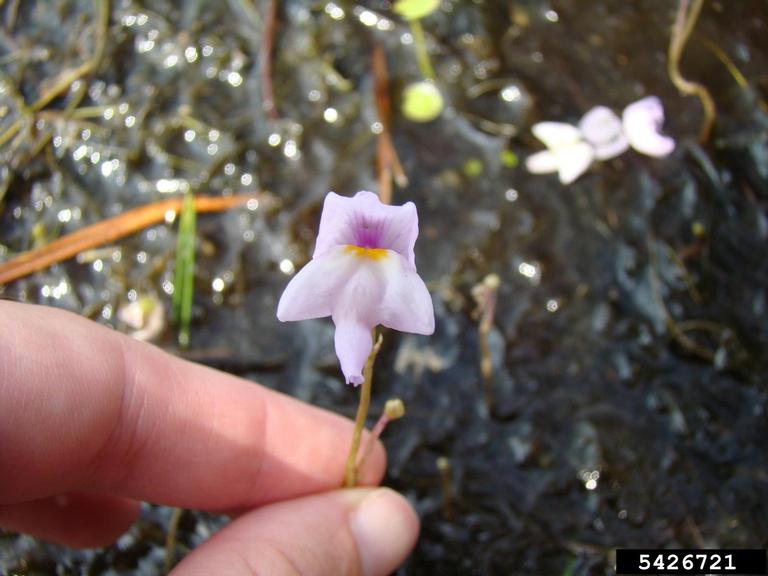
Bladderwort flowers are small but beautiful, and are designed to maximize pollination. This is purple bladderwort (Utricularia purpurea). Photo by Rebekah D. Wallace, University of Georgia, Bugwood.org
Bladderwort flowers are another beautiful feature of this plant. In Florida most species have yellow flowers, some are lavender to purple. The flowers bloom several inches above the water, and their shape is designed to efficiently attract and remove pollen from pollinating insects like bees. Part of the flower is shaped like a spur which contains a nectar reward for pollinating insects. This link, The Utricularia, to a Botanical Society of America publication details the botany and pollination ecology of bladderworts.
We hope this article piques your curiosity about some of Florida’s obscure native, aquatic, carnivorous plants! Maybe you, too, will include them in your list of favorite La Florida plants!
Below are the publications used for this article:
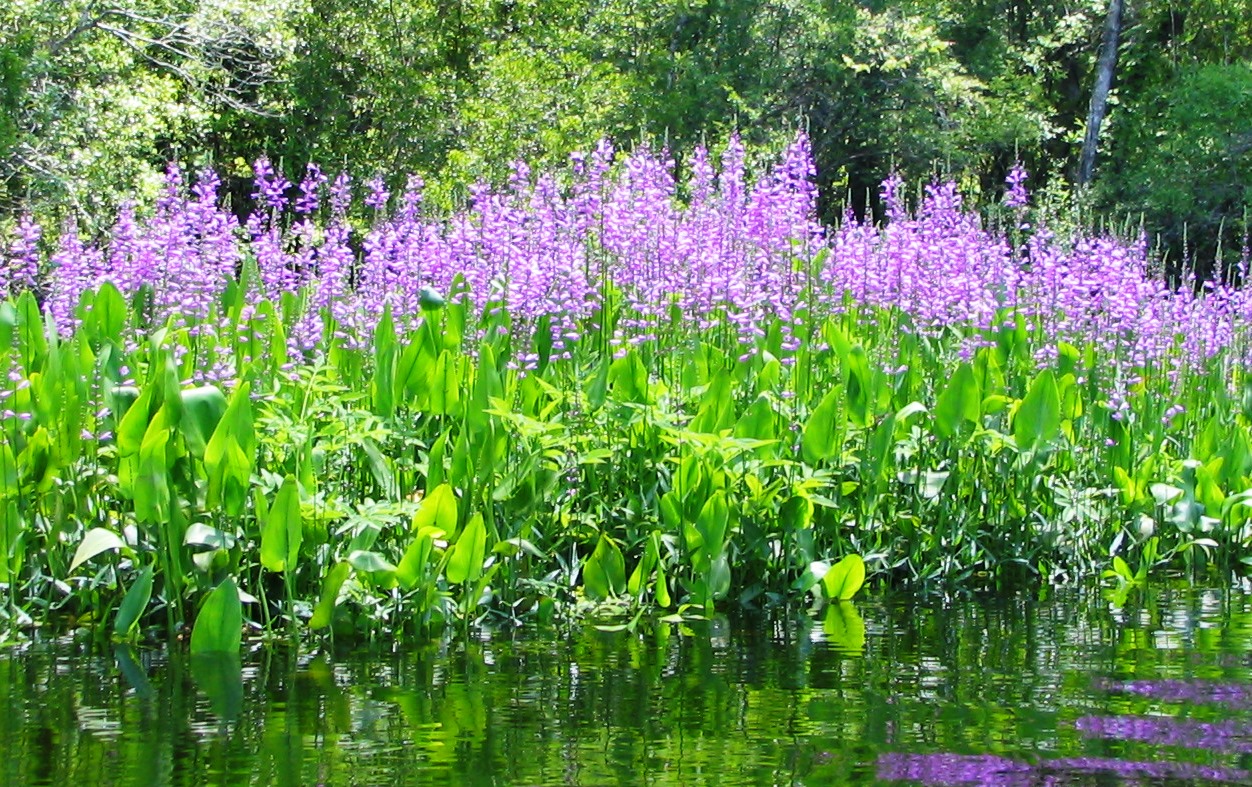
by Judy Biss | Apr 8, 2016

A stand of purple flowers called “False Dragon-Heads (Physostegia spp.) growing along the St. Marks River. They are behind a stand of pickerelweed (Pontederia cordata) that has not yet bloomed. Photo: Judy Biss
This is the time of year when gardens burst forth with lush green growth and colorful flowers. With a little planning and management, your backyard pond can also put on the same show each year and fight unwanted pond weeds at the same time!
Fish and farm ponds are abundant in the Florida panhandle. Most are two acres or less and are used for producing catfish, bass, and bream; for recreation and wildlife viewing; for fishing and swimming; and for irrigation and livestock watering. Ponds play an important role in various aspects of agricultural production and rural life, and for that reason, maintaining their ecological health is critical to their many uses.
Managing aquatic plants is one important component of pond ownership. If you are a pond owner, you have probably seen and read many articles related to controlling and removing aquatic weeds. Just as in terrestrial gardens, there are a number of non-native (and sometimes native) plants that can become quite weedy and problematic in and around your pond. Hydrilla, water hyacinth, torpedograss, Chinese tallow, alligator weed, and the tiny water spangles (common Salvinia) are just a few examples that plague our waterways and shorelines. But, controlling and removing weeds is only part of the bigger picture of pond management. Planting native wetland plants is another ecologically important and aesthetically enriching management tool as well.
By establishing beds of healthy native plants, you are also fighting against weedy non-native invasive plants through competition for space. Some other benefits of native aquatic plants are they act as a barrier, filtering fertilizers such as nitrogen and phosphorus from runoff, and they help control erosion. Also, because native plants are adapted to our local environments, they are generally easy to grow, and most require little or no extra water or fertilizer.
Below are a few guidelines to follow if you are considering the use of native aquatic plants in your pond.
Know Your Plants:
Depending on the type, aquatic plants generally grow in three forms. Emerged, like maidencane or bulrush, submerged like coontail and southern naiad, and floating, like the tiny free floating duckweed, and spatterdock and fragrant water lily which are rooted with floating leaves and flowers at the water’s surface. There are many good UF/IFAS publications and online resources for aquatic plant identification. Some are listed at the end of this article.
Plan Ahead:
Some questions to ask are, what is the primary use of your pond? Is it wildlife viewing, swimming, fishing, irrigation, etc.? The answers to these questions will help you determine how much of your pond and shoreline will be planted, and what types of plants to use. For example, if you use your pond for fishing and irrigation, you should leave some areas of the shore unplanted and mowed to allow for access, and you should not plant submerged plants that may clog irrigation intakes. On the other hand, if your pond is primarily for attracting wildlife, you can plant most of the shoreline including some types of submerged aquatic plants.
Right Plant Right Place:
You may have heard this Florida Friendly Landscaping term before, as it holds true for any garden including aquatic gardens. Choose plants that grow best in the water depth and planting “shelves” you have in and around your pond. By “shelf” we are referring to the slope of your shoreline. Is it a gradual, gentle slope into deeper water, or is it steep and abrupt? Also, become familiar with seasonal changes in your pond’s water depth, as it may affect the plants you select.
Prepare For Maintenance:
Just like a vegetable garden, your newly planted aquatic plants (especially those that are emerged) will need attention in the first year or so of establishment. Remove dead plants and weed out unwanted plants.
Where to Purchase the Plants:
For a list of Florida native plant suppliers, visit the Association of Florida Native Nurseries (AFNN) Please Note: collecting wild plants in Florida is subject to various regulations and may require permits! Visit this website for details on wild collection – Florida Plant Collecting and Transport, Regulations and Permitting, University of Florida Herbarium
Here are some helpful resources used for this article with more detail on establishing aquatic plants around your pond.












